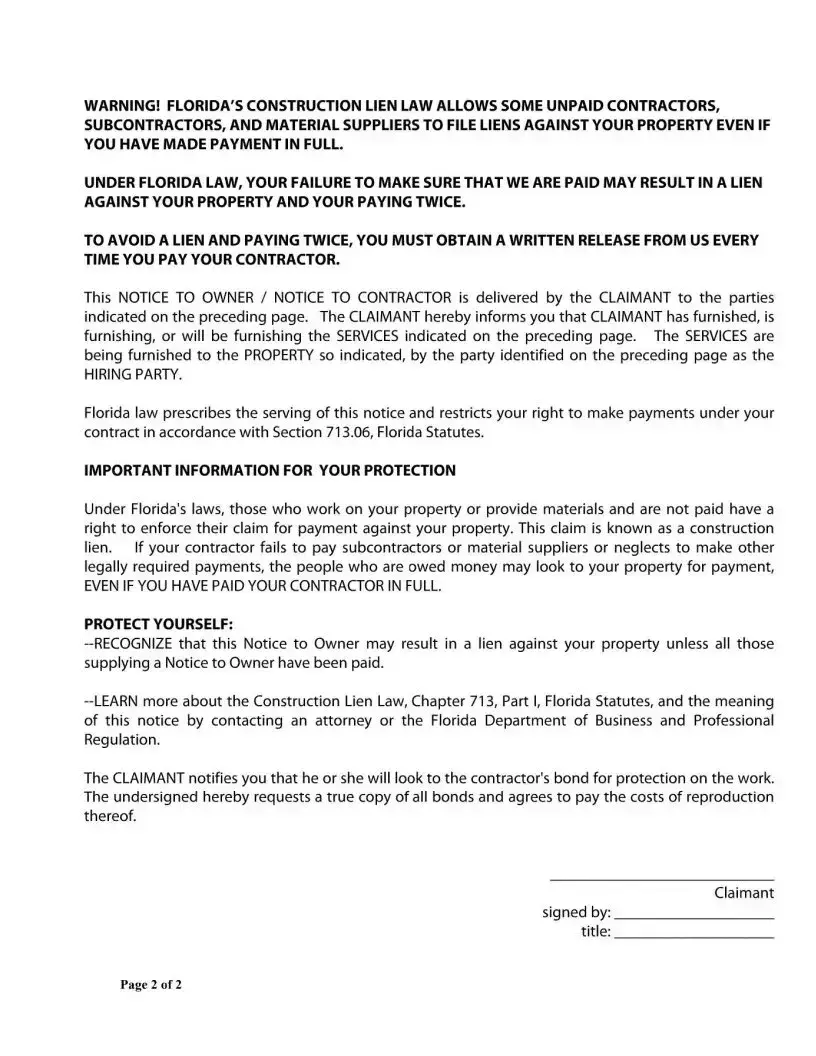What is a Notice to Owner (NTO) in Florida?
A Notice to Owner (NTO) is a legal document that a subcontractor, supplier, or laborer sends to a property owner in Florida to inform them that they have provided or will provide materials, labor, or services to the property. This notice serves to protect the claimant's right to file a lien against the property if they are not paid. Under Florida's Construction Lien Law, this notice is crucial for maintaining the right to claim a lien.
Who needs to send a Notice to Owner, and when should it be sent?
Generally, subcontractors, material suppliers, and laborers who do not have a direct contract with the property owner must send a Notice to Owner. This notice should be sent within 45 days of first supplying labor, services, or materials to the job site to ensure lien rights are preserved.
How does one send a Notice to Owner in Florida?
The Notice to Owner must be sent via certified mail to the property owner, the prime contractor, the construction lender (if applicable), and any other party specified in the notice. Including a certified mail number for each recipient ensures that there is proof the notice was sent.
What information must be included in the Notice to Owner?
The Notice to Owner should include the name and address of the property owner, the prime contractor, any other party who hired the claimant, and the construction lender (if there is one), along with a description of the labor, materials, or services provided. It must also clearly state that it is serving as a Notice to Owner/Notice to Contractor and include information about the claimant, including their name and address.
What happens if a Notice to Owner is not sent in Florida?
If a Notice to Owner is not sent, the subcontractor, supplier, or laborer may lose their right to file a lien against the property if they are not paid. This notice is a critical step in the process of securing a lien under Florida Construction Lien Law.
Can a property owner take any actions after receiving a Notice to Owner?
Yes, after receiving a Notice to Owner, a property owner should verify the claimant's role in the project and ensure that they are paid for their contributions. Owners can protect themselves from liens by obtaining releases of lien from every supplier and subcontractor as payments are made.
What is a construction lien?
A construction lien is a claim made against a property by a contractor, subcontractor, supplier, or laborer who has supplied labor or materials for the property but has not been paid. Under Florida law, if the property owner fails to ensure all parties are paid, they could face a lien against their property, which might result in paying twice for the same work or materials.
Where can someone learn more about the Construction Lien Law in Florida?
To learn more about the Construction Lien Law, property owners and other interested parties should contact an attorney specializing in construction law or the Florida Department of Business and Professional Regulation. These sources can provide detailed information and advice on how to navigate these legal requirements.

